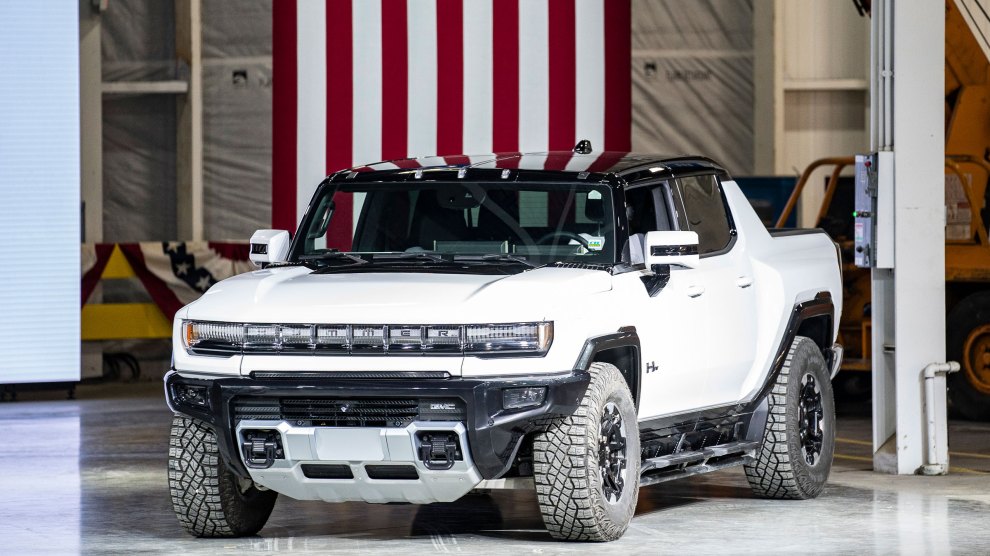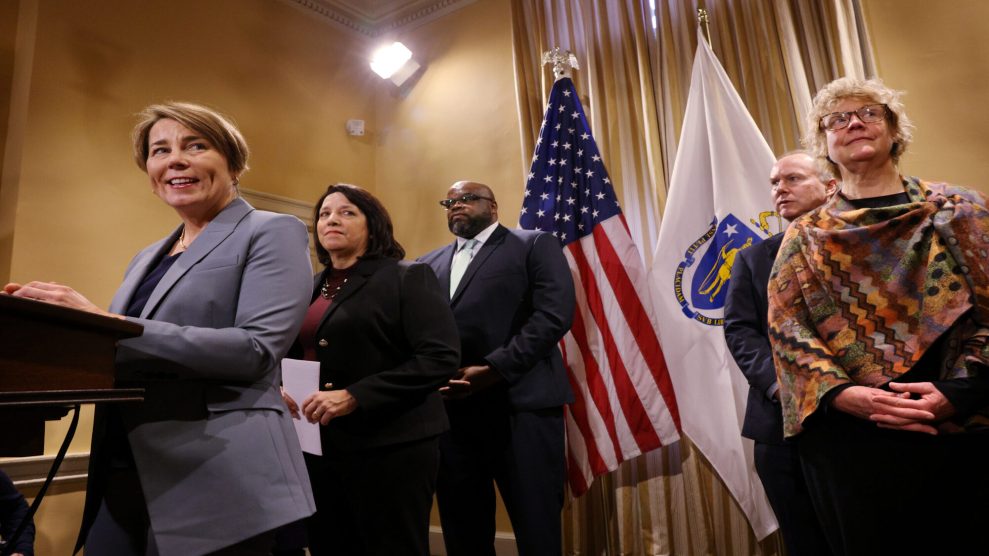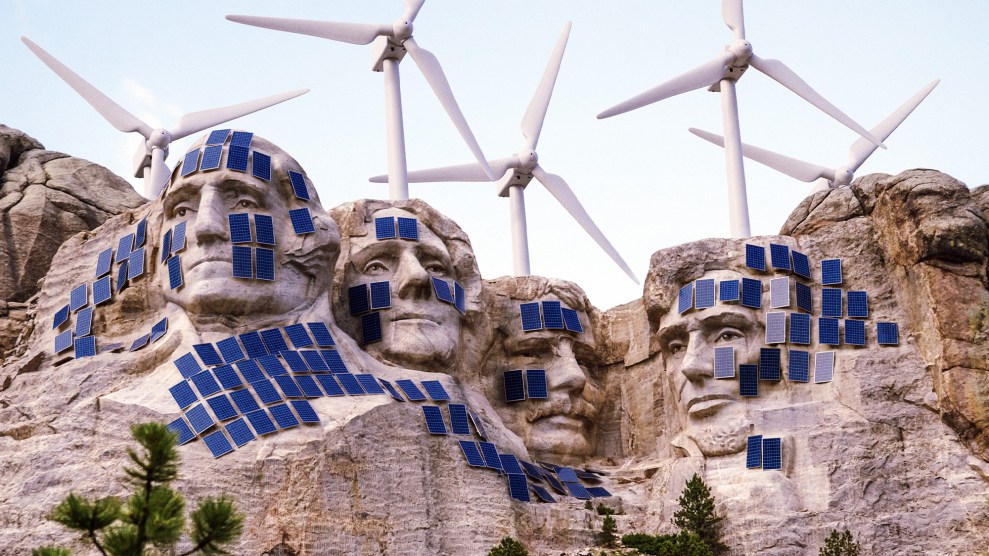
An electric Hummer at the 2021 grand opening of GM's Factory ZERO in Detroit, which featured an appearance by President Joe Biden. Dominick Sokotoff/Zuma
This story was originally published by Grist and is reproduced here as part of the Climate Desk collaboration.
Given America’s penchant for gas-guzzling pickup trucks and SUVs, you might be surprised to learn that the country’s gasoline usage is going down, maybe for good. Even though only about 1 percent of cars on the road today are electric, some say the United States has already passed “peak gasoline”—the pivotal moment when the fuel’s use finally begins a permanent decline after a century of growth.
Gasoline consumption has not fully bounced back to levels seen before local governments began lockdowns in the face of the COVID-19 pandemic, when millions of people stopped driving to work every day. Back in the pre-pandemic year of 2018, Americans burned an average of 392 million gallons of gasoline, more than one gallon every day for every person in the country. Since that annual peak, a combination of remote work, high gas prices, and fuel economy standards that require that new cars get better gas mileage have diminished demand. To stay profitable, oil refiners have cut back on production.
Demand for gasoline this year could end up at around 366 million gallons per day, down 7 percent from 2018, according to analysis provided to Grist by the Rocky Mountain Institute, a clean energy research and advocacy nonprofit. With recent policies like the Inflation Reduction Act offering a tax credit of up to $7,500 for an electric vehicle and the Biden administration’s new emissions rules—which require two-thirds of new passenger vehicles be electric by 2031—gasoline demand could decrease almost a quarter by 2030, according to the research group, compared to current levels.
That’s still not fast enough to hit important targets to slash greenhouse gases, says Janelle London, the co-executive director of Coltura, an organization advocating for the end of gasoline. “Scientists are saying that we have to cut emissions from all sources in half by 2030 to avoid the worst impacts of climate change, and gasoline use just is not on track,” she said.
The majority of the country’s transportation-related carbon emissions come from burning gasoline in cars, trucks, and SUVs. And transportation is currently the country’s largest source of pollution. London says that the fastest way to cut consumption is to target electric vehicle incentives toward “gasoline superusers”: the 10 percent of population that drives the most and guzzles nearly a third of the country’s gas.
That’s not who’s buying electric vehicles right now. The typical EV driver is likely to be among those who drive the least, London said. “The only way we’re going to solve this near-term problem is to get the biggest gasoline users to switch to EVs, like, now, as soon as possible.” California, for instance, is on track for a 10 percent cut in gasoline use by 2030, far from its goal of halving gasoline use by the end of the decade. If superusers in California bought electric vehicles before everyone else, it would result in a steep, 43 percent drop that would move the state much closer to its climate goals.
London says that federal tax credits in the Inflation Reduction Act “could be much better designed,” and she’s not the only one who thinks so. Ashley Nunes, director of federal climate policy at the Breakthrough Institute, an environmental research center, says the credits aren’t necessarily prompting people to give up their gas-powered cars. They’re just adding another vehicle. An estimated 44 percent of households with an electric vehicle have at least two other cars, if not three—nearly all of which run on gas. “First and foremost, I think that electric vehicle incentives should not be given to people who are not turning in their gasoline-powered car,” Nunes said. “We’re not paying for you to add another car in your garage.”
In a study published Wednesday in the journal Sustainable Cities and Society, Nunes and other researchers found that offering blanket subsidies for electric vehicles isn’t an economically effective way of reducing carbon emissions. Targeting subsidies at households with only one vehicle and toward taxi or Uber drivers produces more bang for the federal buck. “You want to target people who drive their cars a lot, because that’s where you see the real emission benefits associated with EVs,” Nunes said.
In some states, there’s new interest in getting frequent drivers to switch to EVs. A bill in Vermont, for instance, would allow the Burlington Electric Department to use funds to help gasoline superusers buy electric vehicles. It passed through the state legislature this month and is headed to Republican Governor Phil Scott’s desk. If signed, it’ll be the first legislation in the country to offer EV incentives specifically to “superusers,” a term coined by Coltura two years ago.
Coltura makes the case that converting the biggest gasoline users into EV owners means less money for gas stations and more for power providers. “Utilities have a huge interest in getting these superusers to switch to EVs,” London said. “Suddenly, they’d be using a lot of electricity, right?” Someone who uses 1,000 gallons of gasoline a year, if switched to an EV, would use about 9,000 kilowatts of extra electricity each year, according to Coltura. Using the average cost of gasoline and electricity in February 2023, that means they’d spend about $1,150 on electricity instead of $3,390 on gas, saving roughly $2,000 a year.
There’s another effort underway in California that would allow superusers to receive more funding, in addition to federal tax credits, to switch. Assembly Bill 1267 would have directed the California Air Resources Board to institute a program that maximizes the reduction in gasoline—and thus the climate impact—for each dollar spent on incentives for superusers.
After passing unanimously through two committee hearings this spring with bipartisan support, the bill died last week. (London said that it will likely be reintroduced next year.) The state already has a hodgepodge of programs that help lower-income residents buy electric cars—including one that offers grants of up to $9,500 to replace a gas guzzler with a cleaner vehicle—though they have suffered from a lack of funding.
The superusers who make less than the state’s median income wind up spending 10 percent of their income just on putting gas in their car. “People say you can’t afford an EV,” London said. “If you’re a superuser, you can’t afford to keep paying for gasoline.”
The average price of an electric car is about $59,000, higher than the $48,000 average for all cars. But London says that average EV cost is “irrelevant” since there are cheaper options on the market. “The question is, is there an EV at the price point that I can afford one?” she asks. While the cheapest EV model, the Chevy Bolt, is being discontinued, a new Nissan Leaf starts at just under $30,000, and tax credits can knock the price down further.
Clayton Stranger, a managing director at the Rocky Mountain Institute, said that there was a “compelling” economic case to target superusers with EV incentives, though the savings alone might not be enough to make people switch: The infrastructure needs to be built in rural places to make people feel comfortable driving an electric car, giving them confidence there’s a place to charge if they need it.
And then there’s the other aspect of ending the gasoline era: getting Americans out of their cars and into buses and trains, and onto bike lanes and sidewalks. “We also need to significantly reduce the amount of driving that is done,” Stranger said. “EVs alone don’t get us all the way there.”












